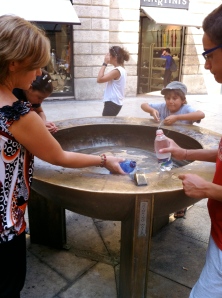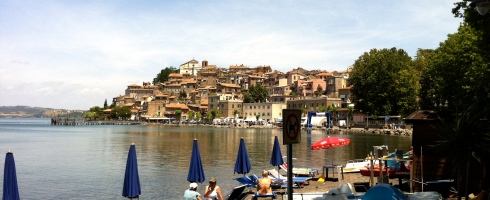I know camping. I’ve camped all my life.
So when I went shopping in Rome with Alessandro for our upcoming camping trip, I personally thought our 3-room tent, 2 queen size air mattresses with chargeable inflator, and collapsable table and chairs were overkill.
After returning from 2.5 weeks of camping in the Austrian Alps I now see we are clearly Euro Camping Amateurs.
How is camping in Europe vs Canada so different?
In Canada, I recall that we went camping to surround ourselves with nature, to rough it a bit. Campsites might be rudimentary but each ideal ultimate camping pitch isolated you from your closest neighbors and made you feel like you were in the midst of the wilderness. You walked to fetch water, to find an outhouse, you cooked over an open fire (a hearty breakfast of eggs fried in bacon grease every morning) and sat at a splintery but familiar picnic table, provided at every site. A campfire is an essential part of the experience, as well as being ridiculously far from anything resembling a city.
Our 5-star Euro camping site (Natterer See, 20 minutes outside of Innsbruck Austria) was a new experience for me. Tucked in a verdant valley within the majestic Alps, the campsite was decked out with every possible consideration. The sites were packed side by side – think high density Euro-urban city rather than spacious Canadian countryside – and horrors! not a camp fire to be found.
Actually, campsites allowing camp fires seems to be a rarity in Europe and this site lists 11 of them in total in Europe on its site. So adjust your pyro expectations. And campsites don’t come with picnic tables either – so bring your own.

And bring your own lounge chairs, dining sets, potted plants, curtains…..note precision alignment of tent without wrinkles
Speaking of which, most campers brought trailers or caravans with them packed with an impressive pile of gear. While I thought our little foldable table and chairs were overkill, everyone else had portable dining sets, hammocks, gravity chairs, BBQs and the works. Our neighbors from Holland actually took pity on us and our little foldable stools, and told us we could sit in their lounge chairs whenever they went out for the day. And we did! Speaking of neighbors they came from Austria, Germany, Holland, Spain, France, Italy, Poland and the UK for the most part.
One of the things we noticed was that our Italian-Canadian tent looked positively droopy compared with it’s German/Austrian/Dutch neighbors.
Natterer See, while not rustic, was certainly in the midst of a stunning environment. And they thought of everything. For kids, they had an amazing lake with water slide, surf boards (alas no surf), water trampoline and climbing iceberg. I loved the lake but 2 of the more fastidious members of our party thought it was murky and therefore dirty.
In addition to this they had a great range of free activities for guests including archery, sumo wrestling and pony rides. One of the best things was the main bathhouse – which was separated into individual showers, family showers, kids showers, and even a dog shower. The main shower facilities were like those of a spa. The shared facilities were literally never dirty or out of order, which is actually better than the average state of my home.
One of the other things that is a pure joy about camping in Europe is that 30 minutes drive away from your pristine valley or hiking path or glacier or whatever are innumerable historic towns and cultural events. So one day a glacier, the next day a castle. And every day a shady cafe with great food. Nice – best of all worlds!

Charming, be-costumed child making something at a traditional street festival in nearby Mittenwald Germany.

If you get bored with stunning nature, why not hop on the road and visit a castle? I forget where, it was east of Innsbruck.
Not to mention that if you are traveling with kids, the Alps are cow country. And that means cow pies. And to David and Aaliyah these provided an endless supply of entertainment even surpassing my iPad. Go figure.
We left our lovely home in Austria to camp near Venice for a couple days – wanting to avoid the scorching heat of Rome as well as the incoming days of rain in the alps. We stayed at Jolly Camping, which I would avoid if I were you. Unless, like you are like a 23-year old student who totally wants to get wasted and use the word party as a verb. The kids liked the pool, but I thought it was vile.
So – camping in Europe. If you are prepared and well situated it can be a great way to explore! Just don’t expect to “get away from it all!” Because yes, the camp grounds even have wifi.






























